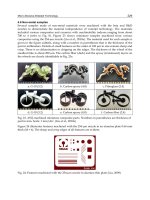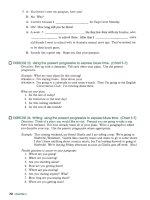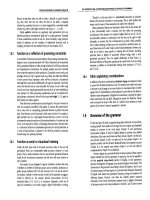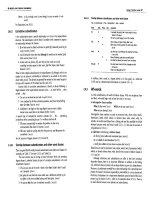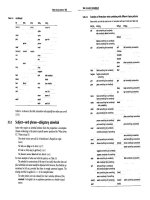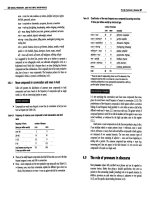Dictionary of Finantial and Business Terms part 13 potx
Bạn đang xem bản rút gọn của tài liệu. Xem và tải ngay bản đầy đủ của tài liệu tại đây (175.36 KB, 10 trang )
121
Dictionary of Finantial and Business Terms
Lico Reis - Consultoria & L?nguas
Rental lease See:full-service lease.
Reoffering yield In a purchase and sale, the
y
ield to maturit
y
at which the underwriter offers to sell the bonds to
investors.
Reopen an issue The Treasury, when it wants to sell additional securities, will occasionally sell more of an
existing issue (reopen it) rather than offer a new issue.
Reorganization Creating a plan to restructure a debtor's business and restore its financial health.
Replacement cost Cost to replace a firm's assets.
Replacement cycle The frequency with which an asset is replaced by an equivalent asset.
Replacement value Current cost of replacin
g
the firm's assets.
Replacement-chain problem Idea that future replacement decisions must be taken into account in selecting
among projects.
Replicating portfolio A portfolio constructed to match an index or benchmark.
Repo A a
g
reement in which one part
y
sells a securit
y
to another part
y
and a
g
rees to repurchase it on a
specified date for a specified price. See: repurchase agreement.
Reported factor The pool factor as reported by the bond buyer for a given amortization period.
Reporting currency The currenc
y
in which the parent firm prepares its own financial statements; that is, U.S.
dollars for a U.S. company.
Reproducible assets A tan
g
ible asset with ph
y
sical properties that can be reproduced, such as a buildin
g
or
machinery.
Repurchase agreement An agreement with a commitment by the seller (dealer) to buy a security back from
the purchaser (customer) at a specified price at a designated future date. Also called a repo, it represents a
collateralized short-term loan, where the collateral may be a Treasury security, money market instrument, federal
agency security, or mortgage-backed security. From the purchaser (customer) perspective, the deal is reported as a reverse
Repo.
Repurchase of stock Device to pay cash to firm's shareholders that provides more preferable tax treatment
for shareholders than dividends. Treasury stock is the name given to previously issued stock that has been
repurchased by the firm. A repurchase is achieved through either a dutch auction, open market, or tender offer.
Required reserves The dollar amounts based on reserve ratios that banks are required to keep on deposit at a
Federal Reserve Bank.
Required return The minimum expected return
y
ou would require to be willin
g
to purchase the asset, that is, to
make the investment.
Required yield Generall
y
referrin
g
to bonds, the
y
ield required b
y
the marketplace to match available returns for
financial instruments with comparable risk.
Reserve An accountin
g
entr
y
that properl
y
reflects the contin
g
ent liabilities.
Reserve currency A forei
g
n currenc
y
held b
y
a central bank or monetar
y
authorit
y
for the purposes of
exchange intervention and the settlement of inter-governmental claims.
122
Dictionary of Finantial and Business Terms
Lico Reis - Consultoria & L?nguas
Reserve ratios Specified percenta
g
es of deposits, established b
y
the Federal Reserve Board, that banks must keep
in a non-interest-bearing account at one of the twelve Federal Reserve Banks.
Reserve requirements The percenta
g
e of different t
y
pes of deposits that member banks are required to hold on
deposit at the Fed.
Reset frequency The frequency with which the floating rate changes.
Residuals (1) Parts of stock returns not explained b
y
the explanator
y
variable (the market-index return). The
y
measure the impact of firm-specific events during a particular period. (2) Remainder cash flows generated by pool
collateral and those needed to fund bonds supported by the collateral.
Residual assets Assets that remain after sufficient assets are dedicated to meet all senior debtholder's claims in
full.
Residual claim Related: equity claim
Residual dividend approach An approach that suggests that a firm pay dividends if and only if acceptable
investment opportunities for those funds are currently unavailable.
Residual losses Lost wealth of the shareholders due to divergent behavior of the managers.
Residual method A method of allocating the purchase price for the acquisition of another firm among the
acquired assets.
Residual risk Related: unsystematic risk
Residual value Usually refers to the value of a lessor's property at the time the lease expires.
Resistance level A price level above which it is supposedl
y
difficult for a securit
y
or market to rise.
Restrictive covenants Provisions that place constraints on the operations of borrowers, such as restrictions on
working capital, fixed assets, future borrowing, and payment of dividend.
Retail Individual and institutional customers as opposed to dealers and brokers.
Retail credit Credit
g
ranted b
y
a firm to consumers for the purchase of
g
oods or services. See: consumer credit.
Retail investors individual investors Small investors who commit capital for their personal account.
Retained earnings Accountin
g
earnin
g
s that are retained b
y
the firm for reinvestment in its operations;
earnings that are not paid out as dividends.
Retention rate The percentage of present earnings held back or retained by a corporation, or one minus the
dividend payout rate. Also called the retention ratio.
Retire To extinguish a security, as in paying off a debt.
Retracement A price movement in the opposite direction of the previous trend.
Return The change in the value of a portfolio over an evaluation period, including any distributions made from
the portfolio during that period.
123
Dictionary of Finantial and Business Terms
Lico Reis - Consultoria & L?nguas
Return on assets (ROA) Indicator of profitabilit
y
. Determined b
y
dividin
g
net income for the past 12 months b
y
total average assets. Result is shown as a percentage. ROA can be decomposed into return on sales (net
income/sales) multiplied by asset utilization (sales/assets).
Return on equity (ROE) Indicator of profitabilit
y
. Determined b
y
dividin
g
net income for the past 12
months by common stockholder equity (adjusted for stock splits). Result is shown as a percentage. Investors use
ROE as a measure of how a company is using its money. ROE may be decomposed into return on assets (ROA)
multiplied by financial leverage (total assets/total equity).
Return on investment (ROI) Generally, book income as a proportion of net book value.
Return on total assets The ratio of earnings available to common stockholders to total assets.
Return-to-maturity expectations A variant of pure expectations theor
y
which su
gg
ests that the return that an
investor will realize by rolling over short-term bonds to some investment horizon will be the same as holding a
zero-coupon bond with a maturity that is the same as that investment horizon.
Revaluation An increase in the foreign exchange value of a currency that is pegged to other currencies or gold.
Revenue bond A bond issued b
y
a municipalit
y
to finance either a pro
j
ect or an enterprise where the issuer pled
g
es
to the bondholders the revenues generated by the operating projects financed, for instance, hospital revenue
bonds and sewer revenue bonds.
Revenue fund A fund accounting for all revenues from an enterprise financed by a municipal revenue bond.
Reverse price risk A t
y
pe of mort
g
a
g
e-pipeline risk that occurs when a lender commits to sell loans to an investor
at rates prevailing at application but sets the note rates when the borrowers close. The lender is thus exposed to the
risk of falling rates.
Reverse repo In essence, refers to a repurchase a
g
reement. From the customer's perspective, the customer
provides a collateralized loan to the seller.
Reverse stock split A proportionate decrease in the number of shares, but not the value of shares of stock held by
shareholders. Shareholders maintain the same percentage of equity as before the split. For example, a 1-for-3 split would
result in stockholders owning 1 share for every 3 shares owned before the split. After the reverse split, the firm's stock
price is, in this example, worth three times the pre-reverse split price. A firm generally institutes a reverse split to
boost its stock's market price and attract investors.
Reversing trade Entering the opposite side of a currently held futures position to close out the position.
Revolving credit agreement A le
g
al commitment wherein a bank promises to lend a customer up to a
specified maximum amount during a specified period.
Revolving line of credit A bank line of credit on which the customer pa
y
s a commitment fee and can take down
and repay funds according to his needs. Normally the line involves a firm commitment from the bank for a period
of several years.
Reward-to-volatility ratio Ratio of excess return to portfolio standard deviation.
Riding the yield curve Bu
y
in
g
lon
g
-term bonds in anticipation of capital
g
ains as
y
ields fall with the
declining maturity of the bonds.
Right A short-lived (typically less than 90 days) call option for purchasing additional stock in a firm, issued b
y
the
firm to all its shareholders on a pro rata basis.
124
Dictionary of Finantial and Business Terms
Lico Reis - Consultoria & L?nguas
Rights offering Issuance of "ri
g
hts" to current shareholders allowin
g
them to purchase additional shares,
usuall
y
at a discount to market price. Shareholders who do not exercise these ri
g
hts are usuall
y
diluted b
y
the offerin
g
.
Rights are often transferable, allowing the holder to sell them on the open market to others who may wish to exercise
them. Ri
g
hts offerin
g
s are particularl
y
common to closed end funds, which cannot otherwise issue additional common
stock.
Rights-on Shares trading with rights attached to them.
Rings Tradin
g
arenas located on the floor of an exchan
g
e in which traders execute orders. Sometimes called a pit.
Risk Typically defined as the standard deviation of the return on total investment. Degree of uncertainty of return
on an asset.
Risk-adjusted profitability A probabilit
y
used to determine a "sure" expected value (sometimes called a
certainty equivalent) that would be equivalent to the actual risky expected value.
Risk arbitrage Speculation on perceived mispriced securities, usuall
y
in connection with mer
g
er and
acquisition deals. Mike Donatelli, John Demasi, Frank Cohane, and Scott Lewis are all hardcore arbs. They had a
huge BT/MCI position in the summer of 1997, and came out smelling like roses.
Risk averse A risk-averse investor is one who, when faced with two investments with the same expected return
but two different risks, prefers the one with the lower risk.
Risk classes Groups of projects that have approximately the same amount of risk.
Risk controlled arbitrage A self-funding, self-hedged series of transactions that generally utilize mortgage
securities as the primary assets.
Risk indexes Cate
g
ories of risk used to calculate fundamental beta, includin
g
(1) market variabilit
y
, (2)
earnings variability, (3) low valuation, (4) immaturity and smallness, (5) growth orientation, and (6) financial risk.
Risk lover A person willin
g
to accept lower expected returns on prospects with hi
g
her amounts of risk.
Risk management The process of identif
y
in
g
and evaluatin
g
risks and selectin
g
and mana
g
in
g
techniques to adapt
to risk exposures.
Risk neutral Insensitive to risk.
Risk prone Willing to pay money to transfer risk from others.
Risk premium The reward for holding the risky market portfolio rather than the risk-free asset. The spread
between Treasury and non-Treasury bonds of comparable maturity.
Risk premium approach The most common approach for tactical asset allocation to determine the relative
valuation of asset classes based on expected returns.
Riskless rate The rate earned on a riskless investment, t
y
picall
y
the rate earned on the 90-da
y
U.S. Treasur
y
Bill.
Riskless rate of return The rate earned on a riskless asset.
Riskless arbitrage The simultaneous purchase and sale of the same asset to
y
ield a profit.
125
Dictionary of Finantial and Business Terms
Lico Reis - Consultoria & L?nguas
Riskless or risk-free asset An asset whose future return is known toda
y
with certaint
y
. The risk free asset is
commonly defined as short-term obligations of the U.S. government.
Risky asset An asset whose future return is uncertain.
Risk-adjusted return Return earned on an asset normalized for the amount of risk associated with that asset.
Risk-free asset An asset whose future return is known today with certainty.
Risk-free rate The rate earned on a riskless asset.
Roll over Reinvest funds received from a maturing security in a new issue of the same or a similar security.
Rollover Most term loans in the Euromarket are made on a rollover basis, which means that the loan is
periodically repriced at an agreed spread over the appropriate, currently prevailing LIBO rate.
Round lot A trading order typically of 100 shares of a stock or some multiple of 100. Related: odd lot.
Round-trip transactions costs Costs of completin
g
a transaction, includin
g
commissions, market impact costs,
and taxes.
Round-turn Procedure b
y
which the Lon
g
or short position of an individual is offset b
y
an opposite
transaction or by accepting or making delivery of the actual financial instrument or physical commodity.
R squared (R
2
) Square of the correlation coefficientthe proportion of the variability in one series that can be
explained by the variability of one or more other series.
Rule 144a SEC rule allowing qualified institutional buyers to buy and trade unregistered securities.
Run A run consists of a series of bid and offer quotes for different securities or maturities. Dealers
g
ive to and ask
for runs from each other.
Rule 415 Rule enacted in 1982 that permits firms to file shelf registration statements.
Safe harbor lease A lease to transfer tax benefits of ownership (depreciation and debt tax shield) from the lessee,
if the lessee could not use them, to a lessor that could use them.
Safekeep For a fee, bankers will hold in their vault, clip coupons on, and present for payment at maturity bonds
and money market instruments.
Safety cushion In a contin
g
ent immunization strate
gy
, the difference between the initiall
y
available
immunization level and the safety-net return.
Safety-net return The minimum available return that will trigger an immunization strategy in a contingent
immunization strategy.
Sale and lease-back Sale of an existing asset to a financial institution that then leases it back to the user. Related
lease.
Sales charge The fee charged by a mutual fund when purchasing shares, usually payable as a commission to marketing
agent, such as a financial advisor, who is thus compensated for his assistance to a purchaser. It represents the
difference, if any, between the share purchase price and the share net asset value.
Sales forecast A ke
y
input to a firm's financial plannin
g
process. External sales forecasts are based on
historical experience, statistical analysis, and consideration of various macroeconomic factors.
126
Dictionary of Finantial and Business Terms
Lico Reis - Consultoria & L?nguas
Sales-type lease An arran
g
ement whereb
y
a firm leases its own equipment, such as IBM leasin
g
its own
computers, thereby competing with an independent leasing company.
Salvage value Scrap value of plant and equipment.
Samurai bond A
y
en-denominated bond issued in Tok
y
o b
y
a non-Japanese borrower. Related: bulldo
g
bond
and Yankee bond.
Samurai market The foreign market in Japan.
Savings and Loan association National- or state-chartered institution that accepts savin
g
s deposits and
invests the bulk of the funds thus received in mortgages.
Savings deposits Accounts that pa
y
interest, t
y
picall
y
at below-market interest rates, that do not have a
specific maturity, and that usually can be withdrawn upon demand.
SBIC Small Business Investment Company.
Scale A bank that offers to pa
y
different rates of interest on CDs of var
y
in
g
rates is said to "post a scale."
Commercial paper dealers also post scales.
Scale enhancing Describes a project that is in the same risk class as the whole firm.
Scale in When a trader or investor gradually takes a position in a security or market over time.
Scalp To trade for small gains. It normally involves establishing and liquidating a position quickly, usually
within the same day.
Scenario analysis The use of horizon anal
y
sis to pro
j
ect bond total returns under different reinvestment rates and
future market yields.
Scheduled cash flows The mort
g
a
g
e principal and interest pa
y
ments due to be paid under the terms of the
mortgage not including possible prepayments.
Search costs Costs associated with locatin
g
a counterpart
y
to a trade, includin
g
explicit costs (such as
advertising) and implicit costs (such as the value of time). Related:information costs.
Seasoned datings Extended credit for customers who order
g
oods in periods other than peak seasons.
Seasoned issue Issue of a security for which there is an existing market. Related: Unseasoned issue.
Seasoned new issue A new issue of stock after the compan
y
's securities have previousl
y
been issued. A
seasoned new issue of common stock can be made by using a cash offer or a rights offer.
SEC The Securities and Exchan
g
e Commission, the primar
y
federal re
g
ulator
y
a
g
enc
y
of the securities
industry.
Second pass regression A cross-sectional re
g
ression of portfolio returns on betas. The estimated slope is the
measurement of the reward for bearing systematic risk during the period analyzed.
Secondary issue (1) Procedure for sellin
g
blocks of seasoned issues of stocks. (2) More
g
enerall
y
, sale of
already issued stock.
Secondary market The market where securities are traded after they are initially offered in the primary market.
Most trading is done in the secondary market. The New York stock Exchange, as well as all other
127
Dictionary of Finantial and Business Terms
Lico Reis - Consultoria & L?nguas
stock exchan
g
es, the bond markets, etc., are secondar
y
markets. Seasoned securities are traded in the
secondary market.
Sector Refers to a
g
roup of securities that are similar with respect to maturit
y
, t
y
pe, ratin
g
, industr
y
, and/or
coupon.
Section 482 United States Department of Treasury regulations governing transfer prices.
Secured debt Debt that, in the event of default, has first claim on specified assets.
Securities & Exchange Commission The SEC is a federal a
g
enc
y
that re
g
ulates the U.S.financial markets.
Securities analysts Related:financial analysts
Securitization The process of creatin
g
a passthrou
g
h, such as the mort
g
a
g
e pass-throu
g
h securit
y
, b
y
which the
pooled assets become standard securities backed by those assets. Also, refers to the replacement of
nonmarketable loans and/or cash flows provided by financial intermediaries with negotiable securities issued in the
public capital markets.
Security Piece of paper that proves ownership of stocks, bonds and other investments.
Security characteristic line A plot of the excess return on a security over the risk-free rate as a function of the
excess return on the market.
Security deposit (initial) S
y
non
y
mous with the term mar
g
in. A cash amount of funds that must be deposited with
the broker for each contract as a guarantee of fulfillment of the futures contract. It is not considered as part pa
y
ment
or purchase. Related: margin
Security deposit (maintenance)Related:Maintenance margin security market line (SML). A description of the
risk return relationship for individual securities, expressed in a form similar to the capital market line.
Security market line Line representing the relationship between expected return and market risk.
Security market plane A plane that shows the equilibrium between expected return and the beta coefficient of
more than one factor.
Security selection See: security selection decision.
Security selection decision Choosing the particular securities to include in a portfolio.
Self-liquidating loan Loan to finance current assets, The sale of the current assets provides the cash to repa
y
the
loan.
Self-selection Consequence of a contract that induces only one group (e.g. low risk individuals) to participate.
Sell hedge Related: short hedge.
Sell limit order Conditional tradin
g
order that indicates that a, securit
y
ma
y
be sold at the desi
g
nated price or
higher. Related: buy limit order.
Selling group All banks involved in selling or marketing a new issue of stock or bonds
Selling shortIf an investor thinks the price of a stock is
g
oin
g
down, the investor could borrow the stock from a
broker and sell it. Eventually, the investor must buy the stock back on the open market. For instance, you borrow
1000 shares of XYZ on Jul
y
1 and sell it for $8 per share. Then, on Au
g
1,
y
ou purchase 1000 shares of XYZ at $7 per
share. You've made $1000 (less commissions and other fees) by selling short.
128
Dictionary of Finantial and Business Terms
Lico Reis - Consultoria & L?nguas
Sell-side analyst Also called a Wall Street analyst, a financial analyst who works for a brokerage firm and
whose recommendations are passed on to the brokerage firm's customers.
Semi-strong form efficiency A form of pricin
g
efficienc
y
where the price of the securit
y
full
y
reflects all public
information (including, but not limited to, historical price and trading patterns). Compare weak form efficiency and
strong form efficiency.
Senior debt Debt that, in the event of bankruptc
y
, must be repaid before subordinated debt receives an
y
payment.
SeniorityThe order of repa
y
ment. In the event of bankruptc
y
, senior debt must be repaid before subordinated debt
is repaid.
Sensitivity analysis Analysis of the effect on a project's profitability due to changes in sales, cost, and so on.
Separation property The propert
y
that portfolio choice can be separated into two independent tasks: 1)
determination of the optimal risky portfolio, which is a purely technical problem, and 2) the personal choice of the
best mix of the risky portfolio and the risk-free asset.
Separation theoremThe value of an investment to an individual is not dependent on consumption
preferences. All investors will want to accept or re
j
ect the same investment pro
j
ects b
y
usin
g
the NPV rule, re
g
ardless of
personal preference.
Serial bonds Corporate bonds arranged so that specified principal amounts become due on specified dates.
Related: term bonds.
Serial covariance The covariance between a variable and the la
gg
ed value of the variable; the same as
autocovariance.
Series bond Bond that may be issued in several series under the same indenture.
Series Options: All option contracts of the same class that also have the same unit of trade, expiration date, and
exercise price. Stocks: shares which have common characteristics, such as ri
g
hts to ownership and votin
g
, dividends,
par value, etc. In the case of many foreign shares, one series may be owned only by citizens of the country in which
the stock is registered.
Set of contracts perspective View of corporation as a set of contractin
g
relationships, amon
g
individuals who
have conflicting objectives, such as shareholders or managers. The corporation is a legal contrivance that serves as the
nexus for the contracting relationships.
Settlement When payment is made for a trade.
Settlement date The date on which pa
y
ment is made to settle a trade. For stocks traded on US exchan
g
es, settlement is
currently 3 business days after the trade. For mutual funds, settlement usually occurs in the U.S.the day
following the trade. In some regional markets, foreign shares may require months to settle.
Settlement price A fi
g
ure determined b
y
the closin
g
ran
g
e which is used to calculate
g
ains and losses in futures
market accounts. Settlement prices are used to determine gains, losses, margin calls, and invoice prices for
deliveries. Related: closing range.
Settlement rate The rate su
gg
ested in Financial Accountin
g
Standard Board (FASB) 87 for discountin
g
the obli
g
ations
of a pension plan. The rate at which the pension benefits could be effectively settled off the pension plan
wished to terminate its pension obligation.
Seykota, Ed Ed Se
y
kota is interviewed b
y
Jack Schwa
g
er in Schwa
g
er's book, Market Wizards. Se
y
kota was
g
raduated
from MIT in the early 1970s, and went on to develop the first commercially sold commodities
129
Dictionary of Finantial and Business Terms
Lico Reis - Consultoria & L?nguas
tradin
g
s
y
stem. Se
y
kota went into business for himself, and in the
y
ears 1974-1989, mana
g
ed to
g
row a $5,000
trading account to over $15 million dollars. Mr. Seykota is a trading genius who has been able to identify
robust patterns of price action that repeat themselves in different markets. His quantitative and systematic
approach to trading has been an inspiration for many. Mr. Seykota is also a genius when it comes
to understanding human psychology.
Share repurchase Pro
g
ram b
y
which a corporation bu
y
s back its own shares in the open market. It is usuall
y
done
when shares are undervalued. Since it reduces the number of shares outstandin
g
and thus increases earnin
g
s per
share, it tends to elevate the market value of the remaining shares held by stockholders.
Shareholders' equity This is a compan
y
's total assets minus total liabilities. A compan
y
's net worth is the same
thing.
Shareholders' letter A section of an annual report where one can find jargon-free discussions by
management of successful and failed strategies which provides guidance for the probing of the rest of the report.
Shares Certificates or book entries representing ownership in a corporation or similar entity
Shark repellant Amendment to company charter intended to protect it against takeover.
Sharpe benchmark A statistically created benchmark that adjusts for a managers' index-like tendencies.
Sharpe ratio A measure of a portfolio's excess return relative to the total variabilit
y
of the portfolio. Related:
treynor index
Shelf registration A procedure that allows firms to file one re
g
istration statement coverin
g
several issues of the
same security.
Shirking The tendenc
y
to do less work when the return is smaller. Owners ma
y
have more incentive to shirk
if they issue equity as opposed to debt, because they retain less ownership interest in the company and
therefore may receive a smaller return. Thus, shirking is considered an agency cost of equity.
Shogun bond Dollar bond issued in Japan b
y
a nonresident.
Shop Wall Street jargon for a firm.
Shopping Seekin
g
to obtain the best bid or offer available b
y
callin
g
a number of dealers and/or brokers.
Short One who has sold a contract to establish a market position and who has not
y
et closed out this position
through an offsetting purchase; the opposite of a long position. Related: Long.
Short bonds Bonds with short current maturities.
Short book See: unmatched book.
Short hedge The sale of a futures contract(s) to eliminate or lessen the possible decline in value ownership of an
approximately equal amount of the actual financial instrument or physical commodity.Related: Long hedge.
Short interest This is the total number of shares of a security that investors have borrowed, then sold in the hope
that the security will fall in value. An investor then buys back the shares and pockets the difference as profit.
130
Dictionary of Finantial and Business Terms
Lico Reis - Consultoria & L?nguas
Short position Occurs when a person sells stocks he or she does not
y
et own. Shares must be borrowed, before
the sale, to make "good delivery" to the buyer. Eventually, the shares must be bought to close out the transaction. This
technique is used when an investor believes the stock price will go down.
Short sale Selling a security that the seller does not own but is committed to repurchasing eventually. It is used
to capitalize on an expected decline in the security's price.
Short selling Establishin
g
a market position b
y
sellin
g
a securit
y
one does not own in anticipation of the price of that
security falling.
Short squeeze A situation in which a lack of suppl
y
tends to force prices upward.
Short straddle A straddle in which one put and one call are sold.
Shortage cost Costs that fall with increases in the level of investment in current assets.
Shortfall risk The risk of falling short of any investment target.
Short-run operating activities Events and decisions concernin
g
the short-term finance of a firm, such as how
much inventory to order and whether to offer cash terms or credit terms to customers.
Short-term financial plan A financial plan that covers the coming fiscal year.
Short-term investment services Services that assist firms in making short-term investments.
Short-term solvency ratios Ratios used to
j
ud
g
e the adequac
y
of liquid assets for meetin
g
short-term
obligations as they come due, including (1) the current ratio, (2) the acid-test ratio, (3) the inventor
y
turnover ratio,
and (4) the accounts receivable turnover ratio.
Short-term tax exempts Short-term securities issued b
y
states, municipalities, local housin
g
a
g
encies, and urban
renewal agencies.
SIC Abbreviation for Standard Industrial Classification. Each 4-di
g
it code represents a unique business
activity.
Side effects Effects of a proposed project on other parts of the firm.
Sight draft Demand for immediate payment.
SIMEX (Singapore International Monetary Exchange) A leadin
g
futures and options exchan
g
e in
Singapore.
Simple prospect An investment opportunit
y
where a certain initial wealth is placed at risk and onl
y
two
outcomes are possible.
Single country fund A mutual fund that invests in individual countries outside the United States.
Single factor model A model of securit
y
returns that acknowled
g
es onl
y
one common factor. See: factor model.
Single index model A model of stock returns that decomposes influences on returns into a s
y
stematic factor, as
measured by the return on the broad market index, and firm specific factors.
Signal The process of conveying information through a firm's actions.



